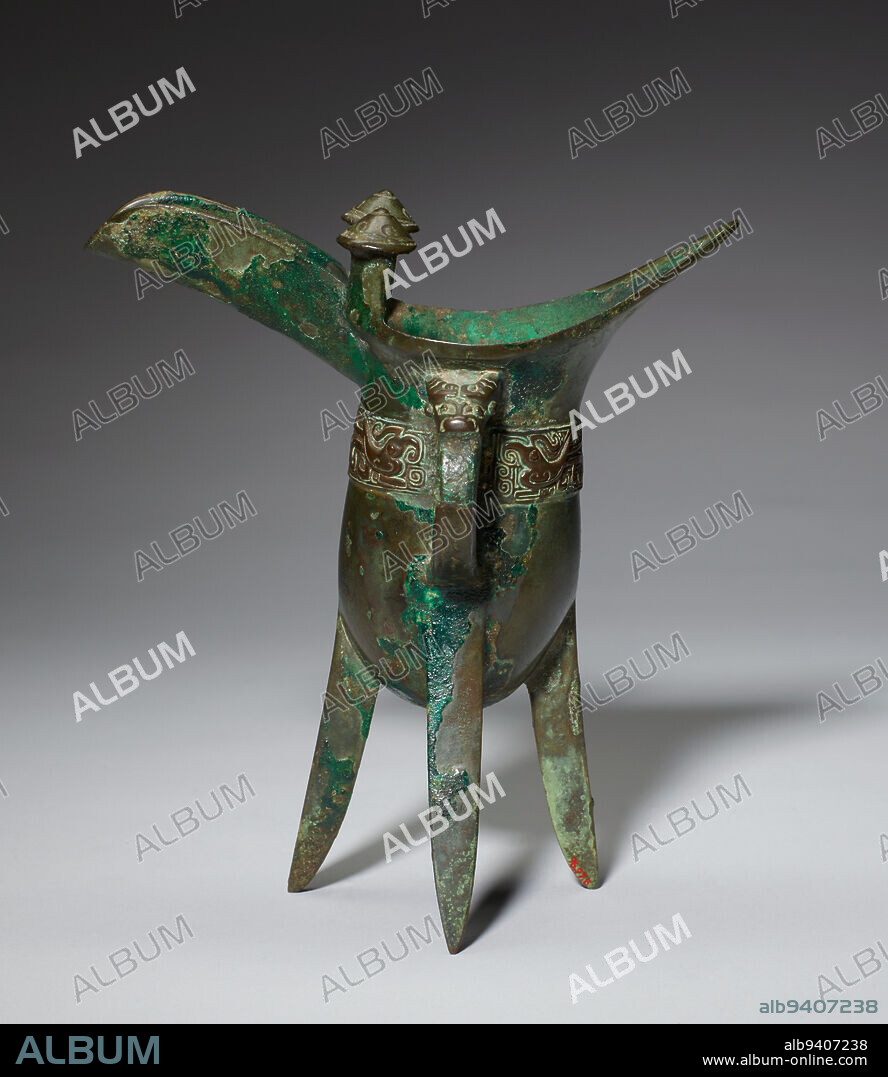alb9407238
Jue libation vessel, 11th century BCE, 7 3/8 × 6 7/16 × 3 1/2 in., 1.3 lb. (18.73 × 16.35 × 8.89 cm, 0.6 kg), Bronze, China, Western Zhou dynasty (c. 1046977 BCE), Jue are one of the earliest ceremonial bronze forms created by artists in the Erlitou culture (c. 20001600 BCE), the first known culture in China to employ advanced bronze technology. The prototype of the bronze jue is a pottery vessel known as gui, found in the late Neolithic Longshan culture (c. 25002000 BCE). A type of wine vessel, Jue flourished during the Shang (c. 16001406 BCE) and early Western Zhou (c. 1406977 BCE) dynasties but diminished in popularity after the midWestern Zhou period in the late 800s BCE. This jue, with its goblet-like body supported by tall blade-shaped legs, is typical of the early Western Zhou dynasty. Its long U-shaped spout is flanked by two capped posts, which are visually and physically balanced by a flaring winglike tail. The decoration on the band consists of two pairs of birds facing a taotie mask. The taotie is a composite animal. The two posts with umbrella-like caps are likely decorative.

|
Ajouter à une autre Lightbox |
|
Ajouter à une autre Lightbox |



Avez-vous déjà un compte? S'identifier
Vous n'avez pas de compte ? S'inscrire
Acheter cette image
Légende:
Voir la traduction automatique
Jue libation vessel, 11th century BCE, 7 3/8 × 6 7/16 × 3 1/2 in., 1.3 lb. (18.73 × 16.35 × 8.89 cm, 0.6 kg), Bronze, China, Western Zhou dynasty (c. 1046977 BCE), Jue are one of the earliest ceremonial bronze forms created by artists in the Erlitou culture (c. 20001600 BCE), the first known culture in China to employ advanced bronze technology. The prototype of the bronze jue is a pottery vessel known as gui, found in the late Neolithic Longshan culture (c. 25002000 BCE). A type of wine vessel, Jue flourished during the Shang (c. 16001406 BCE) and early Western Zhou (c. 1406977 BCE) dynasties but diminished in popularity after the midWestern Zhou period in the late 800s BCE. This jue, with its goblet-like body supported by tall blade-shaped legs, is typical of the early Western Zhou dynasty. Its long U-shaped spout is flanked by two capped posts, which are visually and physically balanced by a flaring winglike tail. The decoration on the band consists of two pairs of birds facing a taotie mask. The taotie is a composite animal. The two posts with umbrella-like caps are likely decorative.
Crédit:
Album / quintlox
Autorisations:
Modèle: Non - Propriété: Non
Questions sur les droits?
Questions sur les droits?
Taille de l'image:
5202 x 5999 px | 89.3 MB
Taille d'impression:
44.0 x 50.8 cm | 17.3 x 20.0 in (300 dpi)
Mots clés:
 Pinterest
Pinterest Twitter
Twitter Facebook
Facebook Copier le lien
Copier le lien Email
Email
